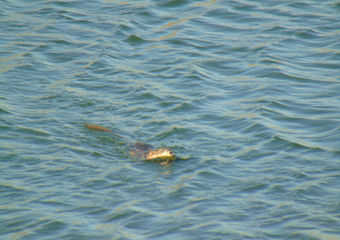Muskrat
Common Name: Muskrat.
Scientific Name: Ondatra Zibethicus.
What to look for? Beaver-like, but smaller. Muskrats have a rounded body with a long, hairless black tail. The back is dark brown and fades gradually to a lighter brown with a reddish tinge on the sides. The black, scaly tail is flattened vertically (like the rudder of a ship) and is almost as long as the body. Muskrats have partially webbed hind feet for swimming and smaller front feet for digging. They have small beady eyes and small, almost hidden ears. Muskrats are sometimes confused with beaver, but the two species are easy to tell apart by looking at the tail. Muskrats have thin, nearly hairless tails that are flattened vertically, while beavers have broad tails that are flattened horizontally. Muskrats are highly specialized for living in the water.
Where can they be found at Carillon Stonegate Pond? You will see Muskrats swimming around the ponds here. Sometimes you may see them dive in order to enter their dens that have an underwater entrance. You may see them with pond grasses in their mouths as they bring food to their dens.
How big are they? The Muskrat is about the same size as a cottontail rabbit. Adults vary from 16 to 25 inches in total length. Muskrats weigh from 1 ½ to 4 pounds. The average weight is about 2 ½ pounds.
How else do they behave? Muskrats are excellent swimmers, thanks to their webbed back feet, laterally flattened tails, and the ability to hold their breath underwater for 15-20 minutes. They are capable of swimming backwards and forwards.
What’s for dinner? Although Muskrats are omnivores, they mainly enjoy a plant-based diet consisting of the roots, stems, leaves and fruits of aquatic vegetation. As local plant food becomes scarce, muskrats will feed on small aquatic animals such as insects, fish and amphibians.
Where do they take up residence? Muskrats inhabit aquatic areas where the water is still or slow moving. They can be found living in ponds, lakes, streams, swamps, marshes, storm water management ponds, and drainage ditches. Muskrats are native to North America, with a range that extends from Canada, down to some northern parts of Mexico. Muskrats are common and live in every county in Illinois. Some of the highest numbers are found in the northern areas of our state.
When and where do they breed and nest? Muskrats breed from March to September with most young born between April and June. Females give birth to 2 to 3 litters per year, each time yielding an average of 4 to 8 pups. Muskrats that live in rivers, ditches and ponds usually don't build houses. Instead, they burrow into the bank, beginning underwater and angling upward until the tunnel clears the water level. Here they hollow out a living chamber. Muskrats are monogamous breeders and live with their mates and their young. They are very territorial, especially during breeding season. Most of the time muskrats mate underwater.
Where do they migrate? Muskrats do not migrate nor do they truly hibernate in the winter. The winter is a period of relative inactivity. In its den, the muskrat is safe from the cold and from most predators. It spends most of its time sleeping and feeding until breeding activities begin after spring break-up.
Do they make any interesting sounds? Muskrats are typically quiet around Carillon Stonegate Ponds. But they will make squeaky sounds occasionally.
Interesting Facts About Muskrats:
-
Muskrats are large rodents, and therefore are related to rats, mice, voles, gerbils, hamsters and lemmings.
-
Muskrats are typically nocturnal (active at night) but may be seen during the day.
-
Muskrat kits are born hairless and blind.
-
Muskrats have a short lifespan; It is estimated that two thirds of the young born each year do not make it through their first winter.
-
Known to be most valuable for their fur or pelts, muskrats are one of the most trapped animals in history.
-
In Illinois, muskrats are protected as Furbearers and may be trapped and removed only if an animal removal permit is issued by an Illinois DNR.
-
In the early 20th century, though, the animal was introduced to northern Eurasia.
-
Muskrats are excellent swimmers.
For more information on Muskrats and sources of information used in this blog (these are the sources that I am using to learn as I blog), please visit Illinois Department of Natural Resources, University of Illinois Extension and Nature Works.
The Carillon at Stonegate community is very fortunate to have a variety of wetland, forest and prairie environments conducive to a variety of birds and other wildlife. Our community and the Kane County Forest Preserve do an exceptional job in maintaining this natural environment – both for the benefit of the birds and wildlife and for our residents to enjoy.
Take a hike and see what you can find – and identify!
























